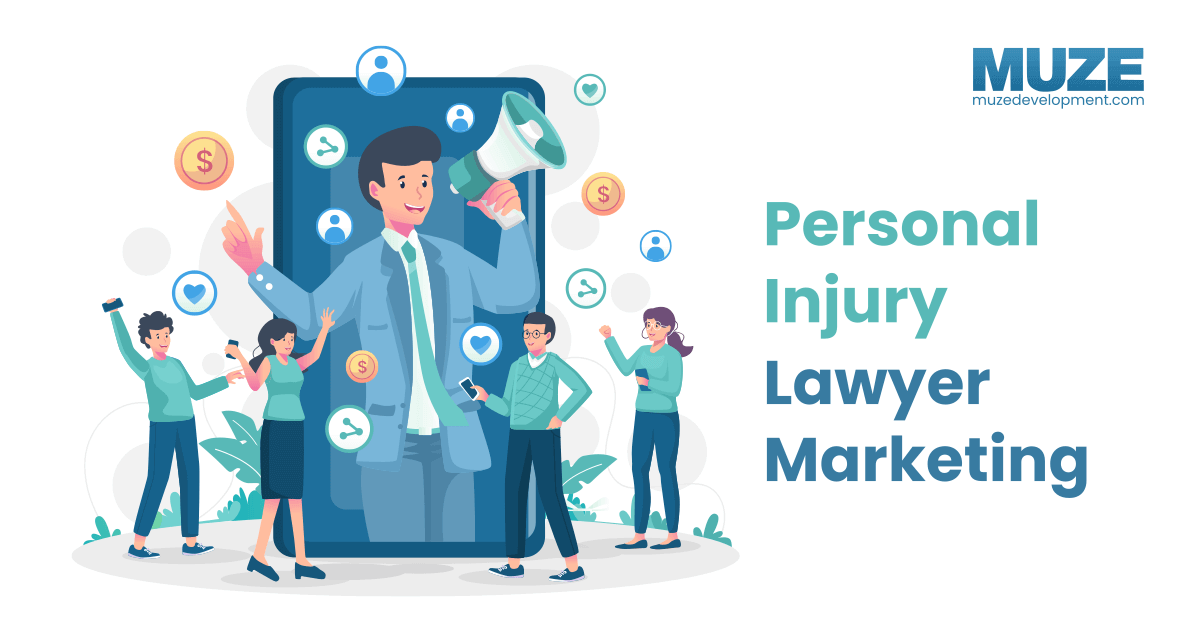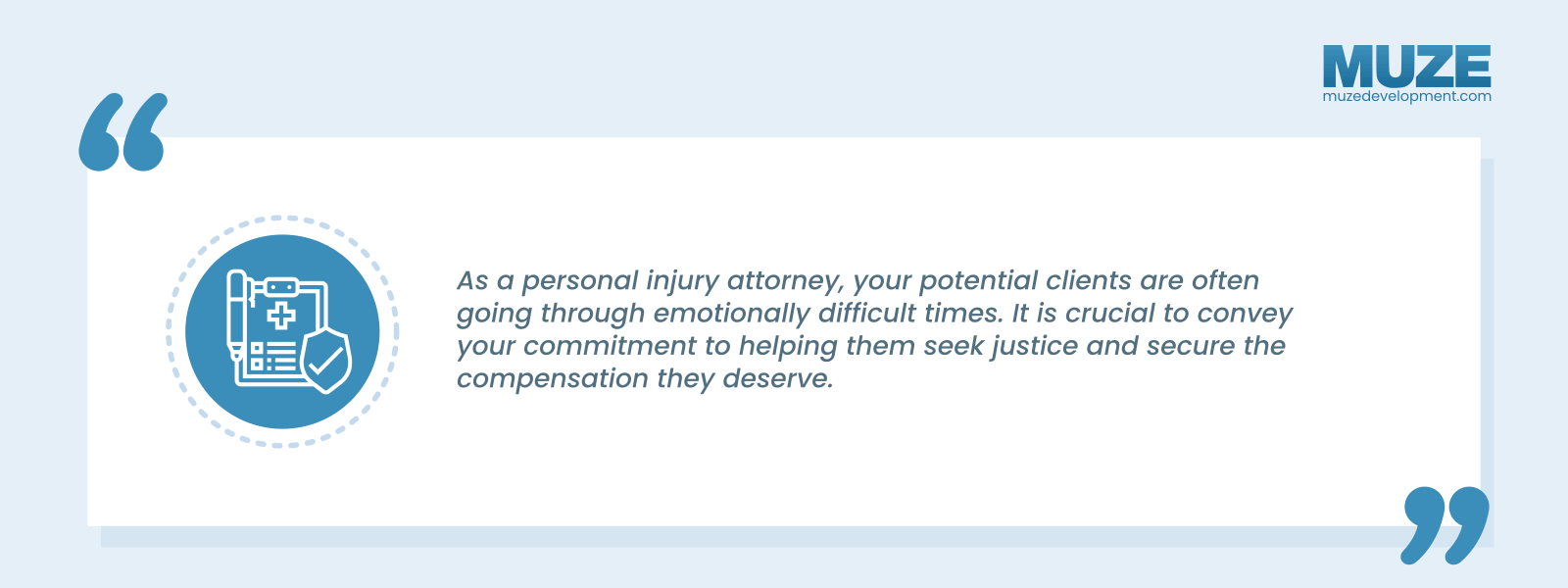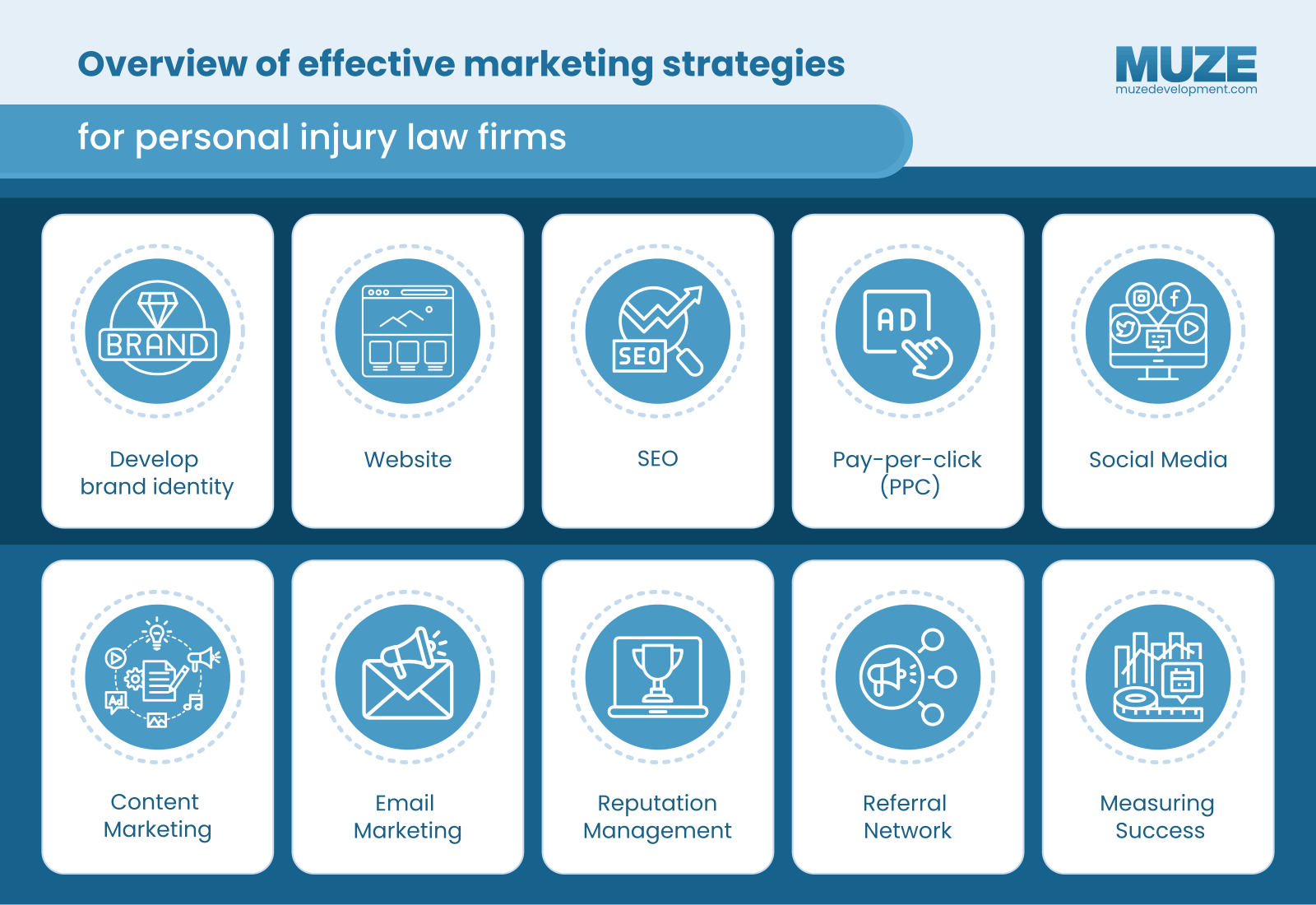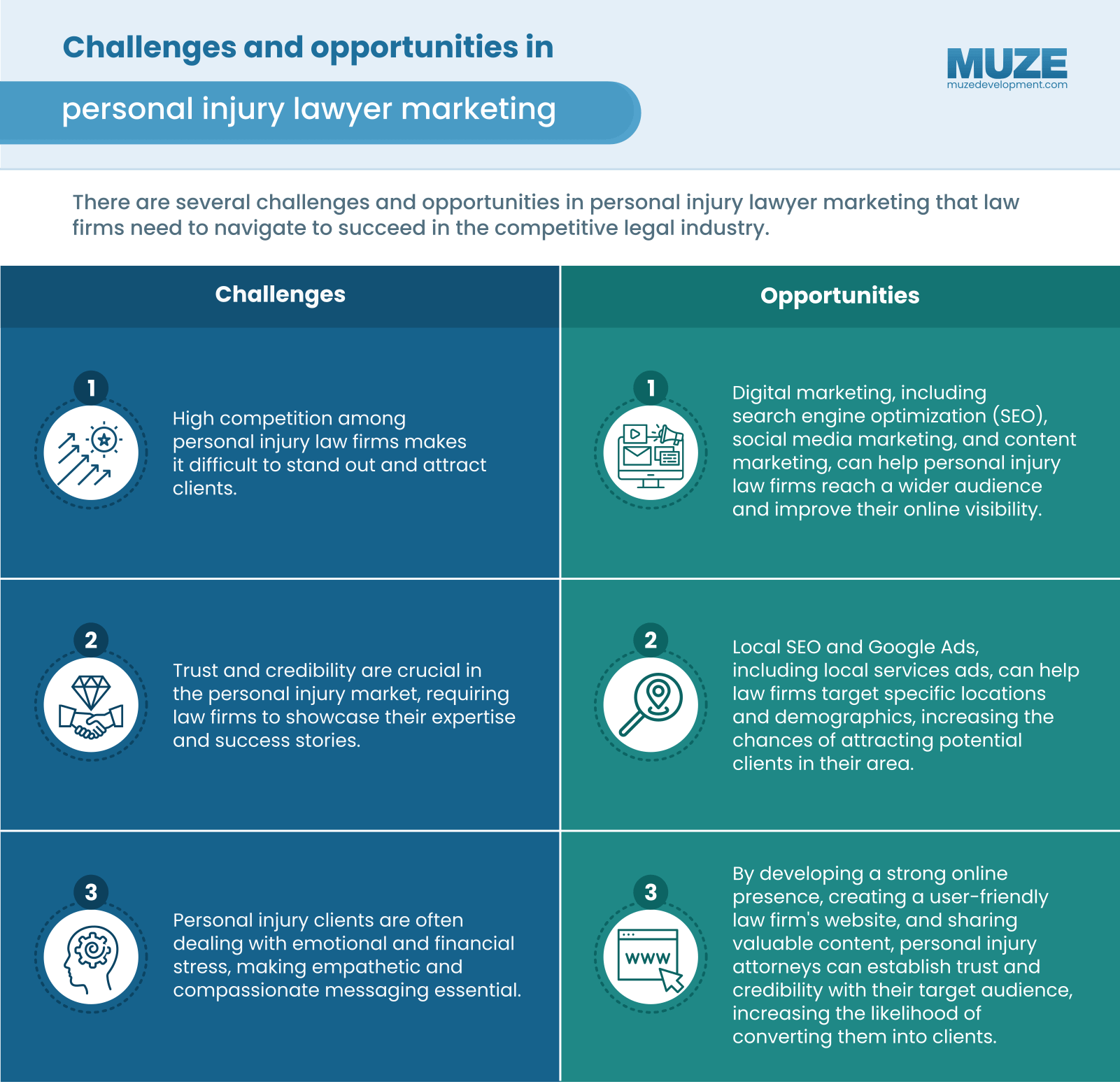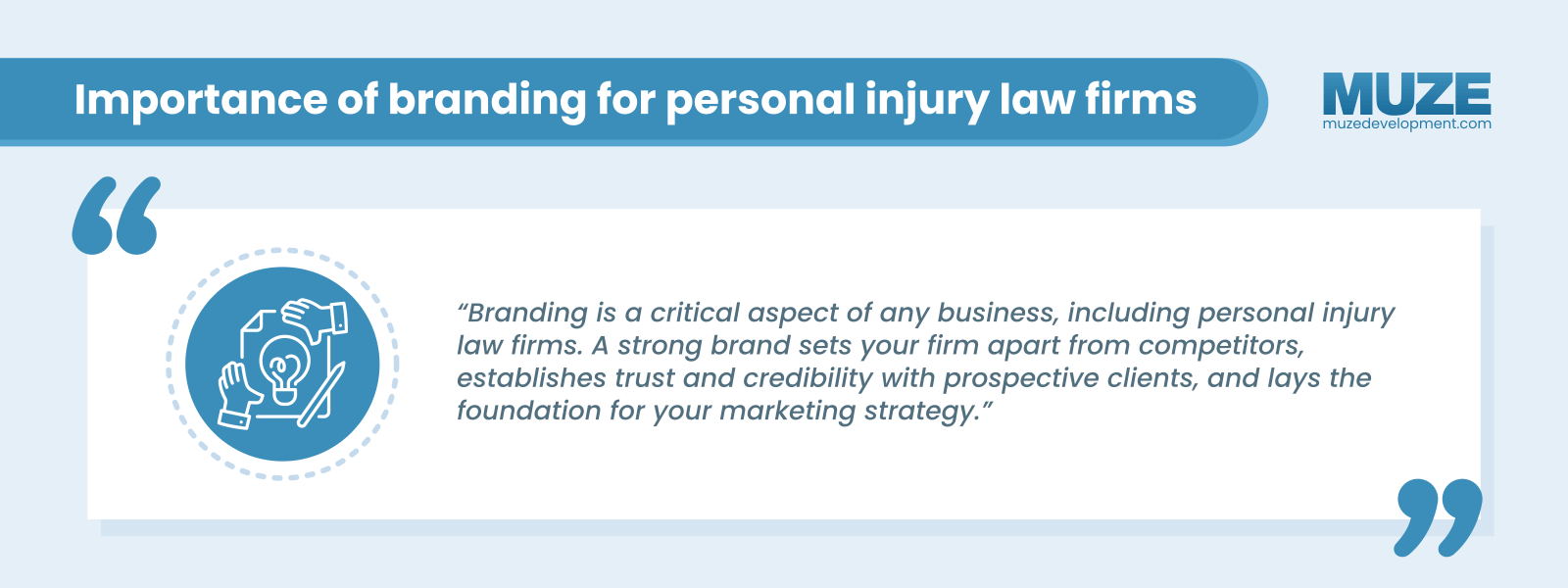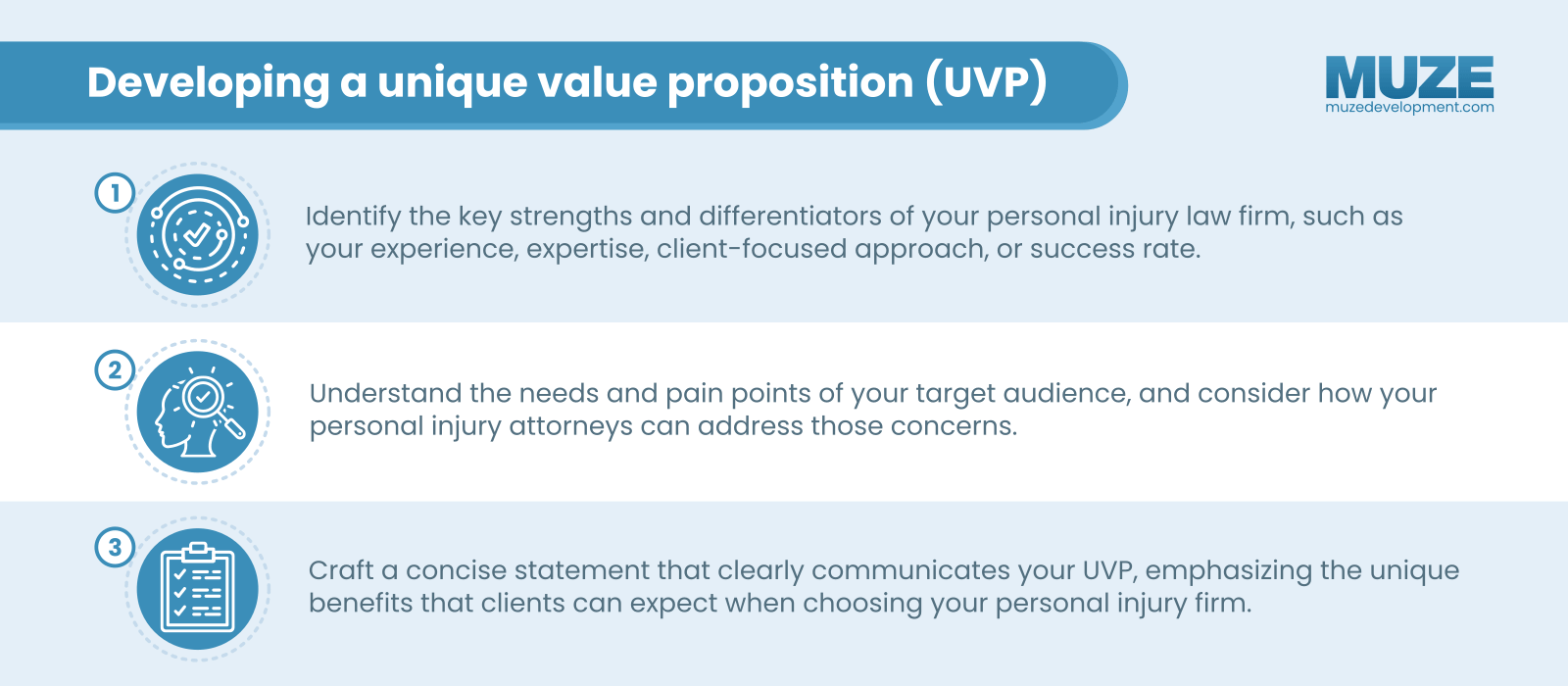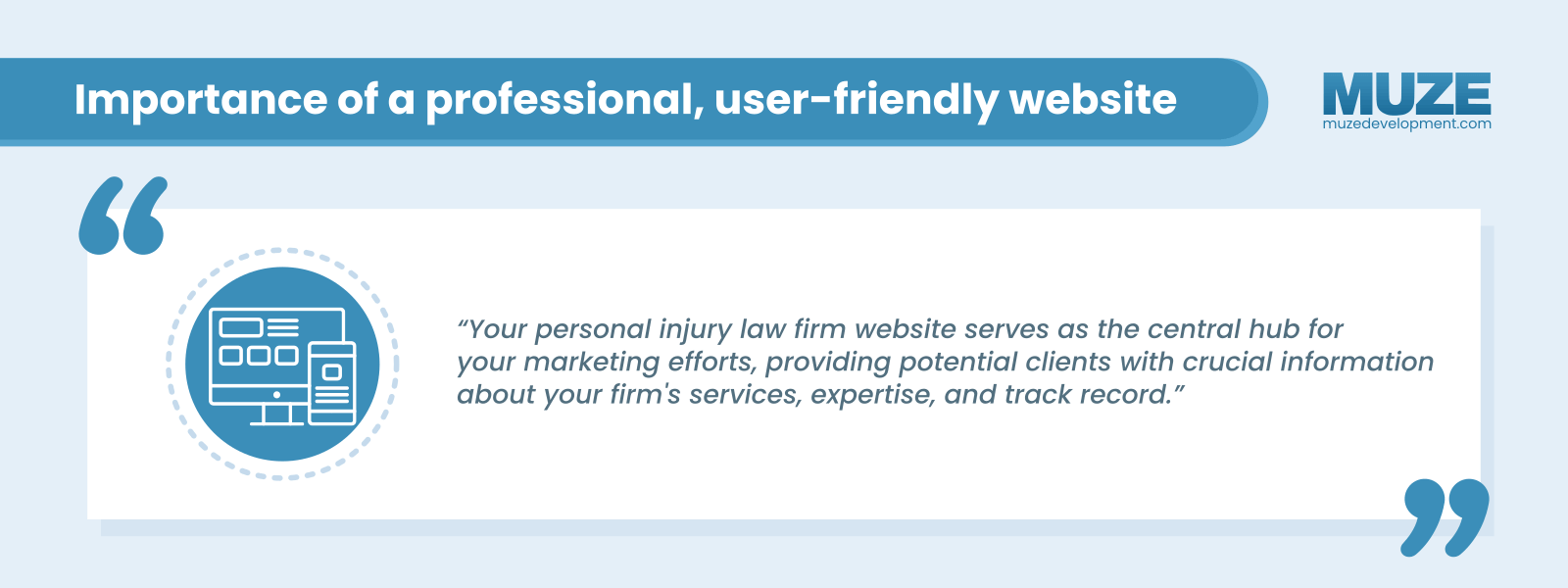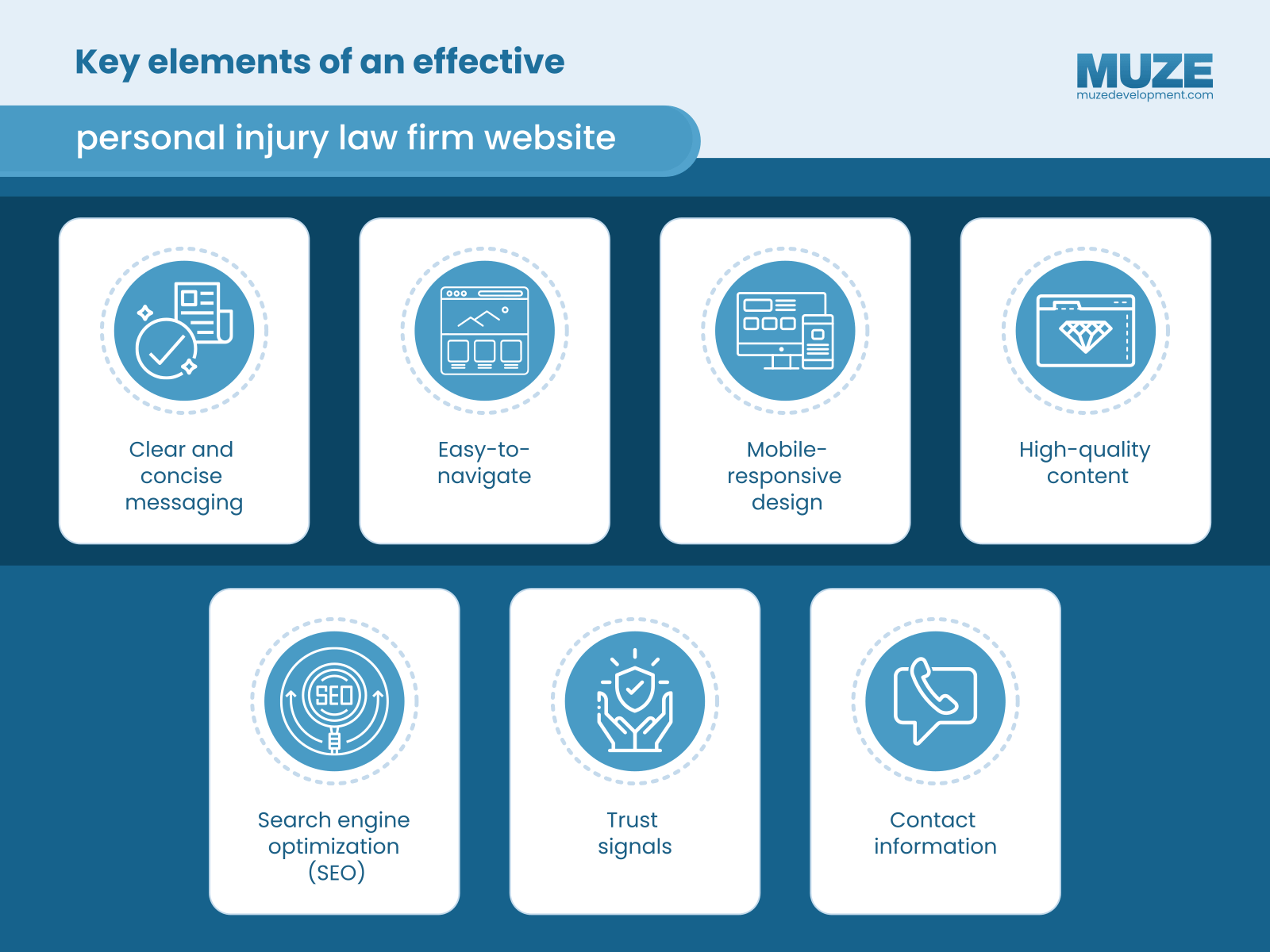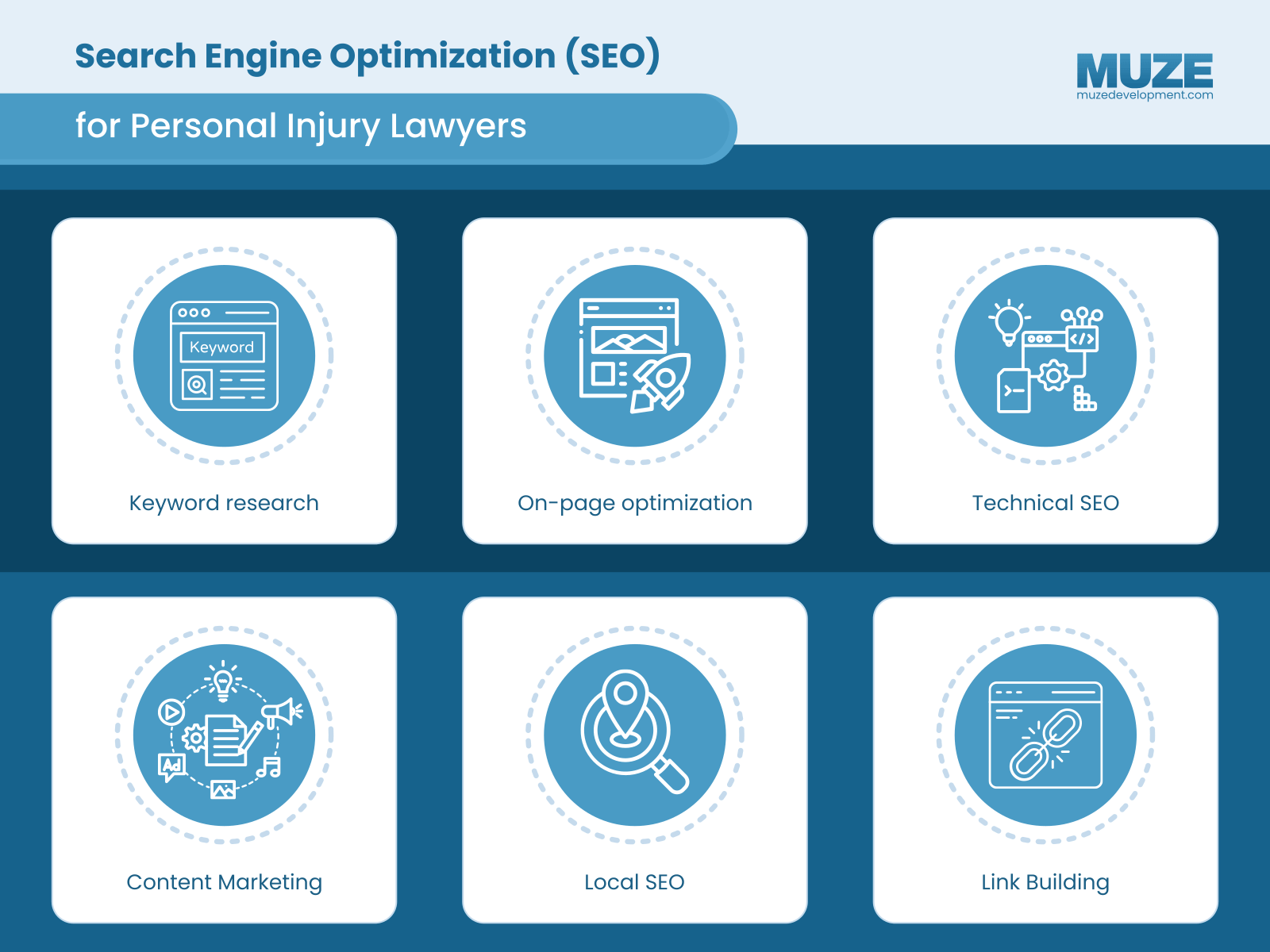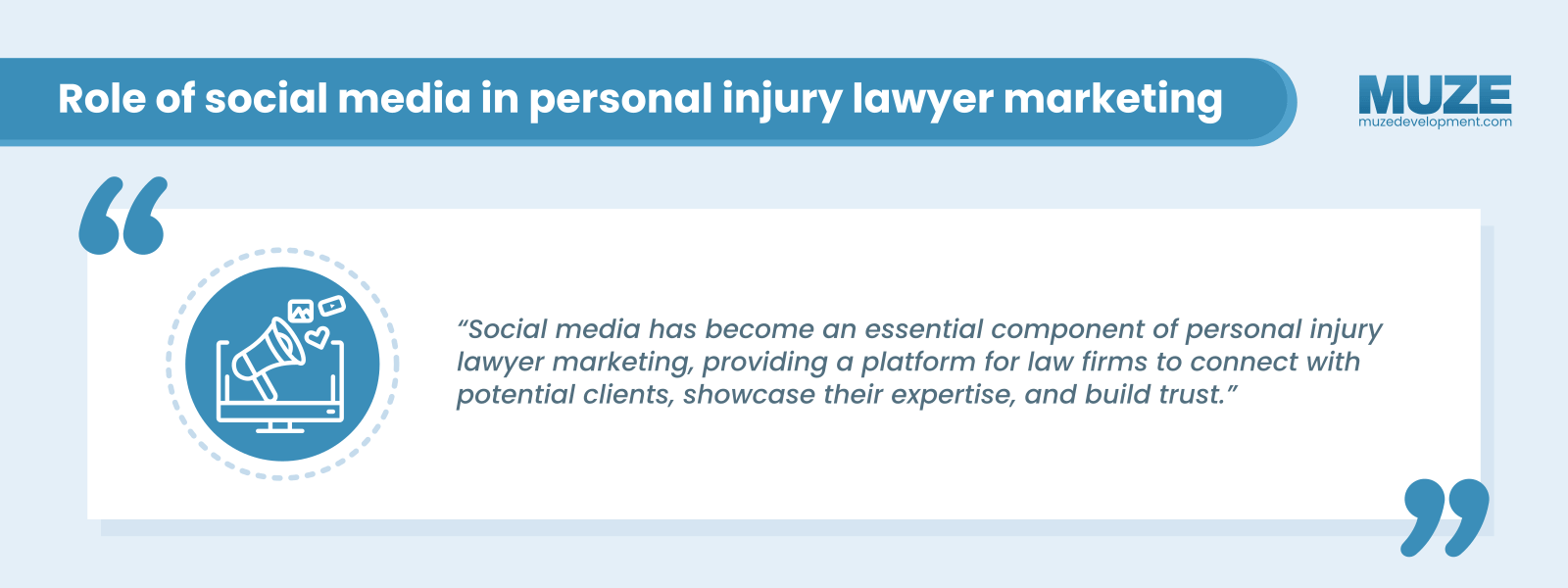Importance of marketing for personal injury lawyers
In today’s competitive legal landscape, personal injury law firms face numerous challenges when trying to attract and maintain a steady flow of cases. Personal injury lawyer marketing has become an essential part of a law firm’s growth strategy, as an increasing number of people turn to the internet for legal advice and representation.
As a personal injury attorney, your potential clients are often going through emotionally difficult times. It is crucial to convey your commitment to helping them seek justice and secure the compensation they deserve. By investing in targeted marketing efforts, you can ensure that your law firm is visible and accessible to those in need of your services. Effective marketing strategies not only raise awareness about your law firm but also establish trust and credibility with prospective clients.
Overview of effective marketing strategies for personal injury law firms
A successful marketing strategy for personal injury law firms comprises various components, each addressing different aspects of online and offline visibility. In this guide, we will delve into the most effective personal injury lawyer marketing strategies, including:
- Developing a well-defined brand identity and unique value proposition to set your personal injury law firm apart.
- Creating a professional, user-friendly lawyer website design that serves as the core of your online presence.
- Implementing search engine optimization (SEO) techniques, including local SEO and personal injury lawyer SEO, to improve your website’s visibility in search engine results.
- Leveraging Google Ads, including local services ads, and other pay-per-click (PPC) advertising to target specific keywords and demographics.
- Harnessing the power of social media marketing to engage with your target audience and enhance your online reputation.
- Creating and distributing high-quality content marketing, showcasing your expertise and addressing the needs of personal injury clients.
- Utilizing email marketing to nurture relationships with prospects and keep your personal injury practice top-of-mind.
- Managing your online reputation by monitoring and responding to client reviews.
- Building a strong referral network through professional relationships and client testimonials.
- Analyzing and measuring the success of your digital marketing efforts to continually optimize your personal injury marketing strategy.
Throughout this guide, we will explore each of these legal marketing strategies in-depth, offering practical advice and actionable tips to help you attract more personal injury clients, increase your caseload, and ultimately grow your personal injury firm. With a well-executed law firm marketing plan and a dedicated marketing budget, you can position your law firm for success in the highly competitive legal industry.
Understanding the Personal Injury Lawyer Market
Market size and competition
The personal injury lawyer market is a competitive space, with a significant number of law firms and attorneys vying for clients. This competition can be attributed to the fact that personal injury claims are often associated with high compensation amounts, making it an attractive practice area for attorneys. As a result, personal injury law firms must implement effective marketing strategies to stand out from the crowd and attract prospective clients.
To succeed in personal injury lawyer marketing, it is crucial to understand your local market and competition. Analyze the strengths and weaknesses of other personal injury law firms in your area, and identify areas where your firm can differentiate itself. By focusing on your unique selling points and targeting specific niches within the personal injury market, you can gain a competitive edge and increase your chances of attracting potential clients.
Target audience and client personas
To create an effective marketing strategy, personal injury law firms need to understand their target audience and develop client personas. Personal injury clients can come from various backgrounds and demographics, but they typically share the common experience of suffering from injuries due to someone else’s negligence.
When developing client personas for your personal injury practice, consider factors such as age, gender, income, location, and the types of injuries they have sustained. Additionally, think about the emotional and psychological factors that motivate clients to seek legal representation, such as the desire for justice, financial compensation, and closure.
By understanding your target audience’s needs, preferences, and pain points, you can tailor your marketing messages and content to resonate with them, increasing the likelihood of converting them into clients.
Challenges and opportunities in personal injury lawyer marketing
There are several challenges and opportunities in personal injury lawyer marketing that law firms need to navigate to succeed in the competitive legal industry.
Challenges:
- High competition among personal injury law firms makes it difficult to stand out and attract clients.
- Trust and credibility are crucial in the personal injury market, requiring law firms to showcase their expertise and success stories.
- Personal injury clients are often dealing with emotional and financial stress, making empathetic and compassionate messaging essential.
Opportunities:
- Digital marketing, including search engine optimization (SEO), social media marketing, and content marketing, can help personal injury law firms reach a wider audience and improve their online visibility.
- Local SEO and Google Ads, including local services ads, can help law firms target specific locations and demographics, increasing the chances of attracting potential clients in their area.
- By developing a strong online presence, creating a user-friendly law firm’s website, and sharing valuable content, personal injury attorneys can establish trust and credibility with their target audience, increasing the likelihood of converting them into clients.
Understanding the personal injury lawyer market’s challenges and opportunities can help your law firm develop a targeted and effective marketing strategy, ultimately setting you apart from the competition and increasing your caseload.
Building a Strong Foundation: Your Law Firm’s Brand
A. Importance of branding for personal injury law firms
Branding is a critical aspect of any business, including personal injury law firms. A strong brand sets your firm apart from competitors, establishes trust and credibility with prospective clients, and lays the foundation for your marketing strategy.
In the highly competitive personal injury market, a well-defined brand helps potential clients recognize your law firm and associate it with positive attributes, such as expertise, professionalism, and empathy. By investing in your law firm’s brand, you can create a lasting impression that resonates with your target audience and ultimately drives more clients to your practice.
Developing a unique value proposition
Your unique value proposition (UVP) is a crucial component of your law firm’s brand. It communicates what sets your personal injury practice apart from other law firms and highlights the specific benefits that clients can expect when working with you. To develop a compelling UVP, consider the following:
- Identify the key strengths and differentiators of your personal injury law firm, such as your experience, expertise, client-focused approach, or success rate.
- Understand the needs and pain points of your target audience, and consider how your personal injury attorneys can address those concerns.
- Craft a concise statement that clearly communicates your UVP, emphasizing the unique benefits that clients can expect when choosing your personal injury firm.
By developing a strong UVP, you can effectively differentiate your law firm from competitors and give potential clients a compelling reason to choose your services.
Creating a consistent visual identity and messaging
A consistent visual identity and messaging are essential for building a recognizable and memorable personal injury law firm brand. Your visual identity includes elements such as your logo, color scheme, typography, and imagery, while your messaging encompasses your firm’s tone, voice, and the language used in your marketing materials.
To create a consistent visual identity and messaging for your law firm, follow these steps:
- Choose a color scheme that reflects your firm’s personality and values, and use it consistently across all marketing materials, including your law firm’s website and social media profiles.
- Design a professional logo that embodies your firm’s unique value proposition and appeals to your target audience.
- Develop a consistent tone and voice for your messaging, ensuring that it resonates with your prospective clients and conveys your personal injury attorneys’ expertise and empathy.
- Use high-quality, relevant imagery that reflects your firm’s values and the services you provide.
By establishing a consistent visual identity and messaging, you can create a cohesive brand experience that leaves a lasting impression on potential clients and supports your personal injury marketing efforts.
Your Law Firm’s Website: The Core of Your Online Presence
Importance of a professional, user-friendly website
A professional, user-friendly website is essential for any personal injury law firm looking to establish a strong online presence. It serves as the central hub for your marketing efforts, providing potential clients with crucial information about your firm’s services, expertise, and track record. Your law firm’s website also plays a critical role in generating qualified leads, as it’s often the first point of contact between prospective clients and your firm.
Key elements of an effective personal injury law firm website
An effective personal injury law firm website should include the following key elements:
- Clear and concise messaging that communicates your unique value proposition and highlights your personal injury attorneys’ expertise.
- Easy-to-navigate design that allows potential clients to find relevant information quickly and effortlessly.
- Mobile-responsive design to ensure your website looks and functions well on all devices, including mobile phones and tablets.
- High-quality, relevant content that addresses your target audience’s needs and showcases your personal injury lawyers’ knowledge and experience.
- Search engine optimization (SEO) techniques to improve your website’s visibility in search engine results and attract more organic traffic.
- Trust signals, such as client testimonials, case results, and professional affiliations, to establish credibility and reassure prospective clients of your firm’s capabilities.
- Contact information and clear calls-to-action (CTAs) that encourage potential clients to get in touch with your personal injury firm.
Conversion optimization techniques
To maximize the effectiveness of your law firm’s website, you should employ conversion optimization techniques to turn website visitors into clients. Some key strategies include:
- Creating persuasive, benefit-focused CTAs that motivate potential clients to take action, such as contacting your firm or scheduling a consultation.
- Utilizing forms and live chat options to provide visitors with multiple ways to connect with your personal injury attorneys.
- Offering free resources, such as eBooks, guides, or case evaluations, in exchange for contact information to generate leads and nurture relationships with potential clients.
- Monitoring website analytics to identify areas for improvement and optimize user experience.
- A/B testing various website elements, such as headlines, CTAs, and images, to determine which versions yield the best results and drive more conversions.
By focusing on these conversion optimization techniques, you can increase the likelihood of turning website visitors into clients, ultimately growing your personal injury practice and generating a higher return on your marketing investment.
Search Engine Optimization (SEO) for Personal Injury Lawyers
Importance of SEO in personal injury lawyer marketing
In the highly competitive personal injury space, search engine optimization (SEO) is a critical component of a successful online marketing strategy. SEO helps improve your law firm’s visibility in search engine results, driving more organic traffic to your website and increasing the chances of generating qualified leads. By investing in SEO, personal injury law firms can enhance their online presence, attract potential clients, and ultimately grow their practice.
Keyword research and strategy
Keyword research is the foundation of a successful SEO campaign. By identifying the right keywords, you can optimize your website and content to rank higher in search engine results and reach your target audience. To develop an effective keyword strategy for personal injury lawyer marketing, consider the following steps:
- Brainstorm a list of relevant keywords and phrases related to your personal injury practice, including terms such as “personal injury lawyer,” “car accidents,” and “injury law firm marketing.”
- Use keyword research tools to identify search volume, competition, and long-tail keyword opportunities.
- Analyze your competitors’ keyword strategies and identify gaps you can capitalize on.
- Organize your keywords into thematic groups to create targeted content and optimize your website.
- Monitor keyword performance and adjust your strategy as needed to maintain and improve rankings.
On-page optimization
On-page optimization involves optimizing the content and HTML source code of your law firm’s website to improve its relevance and ranking potential for target keywords. Key on-page optimization techniques for personal injury lawyers include:
- Writing unique, high-quality content that addresses your target audience’s needs and includes your target keywords.
- Creating descriptive, keyword-rich title tags and meta descriptions to help search engines understand your content and encourage clicks from search engine results pages.
- Utilizing header tags (H1, H2, H3) to structure your content and emphasize important keywords.
- Ensuring your website is mobile-friendly, as search engines prioritize mobile-responsive designs.
- Optimizing your site’s images by compressing them and using descriptive alt tags.
Technical SEO
Technical SEO focuses on improving your law firm’s website structure and performance to provide a better user experience and make it easier for search engines to crawl and index your content. Key technical SEO considerations for personal injury lawyers include:
- Ensuring your website has a clean and logical site structure, with clear navigation and a comprehensive internal linking strategy.
- Improving website load times by optimizing images, leveraging browser caching, and minimizing redirects.
- Ensuring your website is secure by implementing HTTPS and addressing any security vulnerabilities.
- Creating and submitting an XML sitemap to search engines to help them discover and index your content.
- Identifying and fixing any crawl errors or broken links.
Content marketing
Content marketing plays a crucial role in personal injury lawyer SEO, as it helps establish your firm as an authority in the legal industry, engages your target audience, and attracts backlinks. To develop a successful content marketing strategy, consider the following:
- Creating a content calendar to plan and schedule regular blog posts, articles, and resources that address your target audience’s needs and interests.
- Producing high-quality, informative content that showcases your personal injury attorneys’ expertise and adds value to your audience.
- Promoting your content through social media networks, email marketing, and outreach to relevant industry influencers.
- Monitoring your content’s performance and adjusting your strategy as needed to maximize engagement, traffic, and conversions.
Local SEO and Google My Business optimization
Local SEO is particularly important for personal injury lawyers, as potential clients often search for legal representation within their geographic area. To optimize your law firm’s local SEO, take the following steps:
- Claim and optimize your Google My Business (GMB) listing, ensuring all information is accurate and up-to-date, including your firm’s name, address, phone number, website, and business hours.
- Encourage past clients to leave reviews on your GMB listing to improve your reputation and visibility in local search results.
- Add relevant categories to your GMB listing, such as “Personal Injury Lawyer” and “Law Firm,” to help Google understand your business.
- Embed a Google map on your law firm’s website to help users find your location easily.
- Build local citations by listing your law firm in reputable online legal directories and local business directories.
- Optimize your website content and meta tags for local keywords, such as “personal injury lawyer [city name]” or “injury law firm [city name].”
Link building
Link building is a vital component of SEO, as search engines view backlinks as an indicator of a website’s authority and relevance. A strong backlink profile can improve your personal injury law firm’s search engine rankings and drive more organic traffic to your website. Consider the following link building strategies:
- Create high-quality, shareable content that naturally attracts backlinks from authoritative websites in the legal industry and related niches.
- Reach out to industry influencers, bloggers, and journalists to share your content and request backlinks.
- Participate in local events, sponsorships, or community initiatives to gain local backlinks and improve your local SEO.
- Guest post on relevant industry blogs and websites to showcase your expertise and generate backlinks.
- Monitor your backlink profile and disavow any low-quality or spammy links that could harm your website’s search engine rankings.
By implementing these SEO strategies, personal injury lawyers can improve their website’s visibility in search engine results, attract more potential clients, and ultimately grow their practice. Remember that SEO is an ongoing process, and regular monitoring and adjustments are necessary to maintain and improve your rankings in an extremely competitive industry.
Pay-Per-Click (PPC) Advertising for Personal Injury Lawyers
Overview of PPC advertising for personal injury law firms
Pay-Per-Click (PPC) advertising is a powerful online marketing strategy that allows personal injury law firms to bid on targeted keywords and display ads in search engine results. PPC ads can drive immediate traffic to your website and generate qualified leads, making it an essential component of a comprehensive personal injury lawyer marketing plan.
Google Ads and Microsoft Advertising
The two primary platforms for PPC advertising are Google Ads and Microsoft Advertising (formerly Bing Ads). Both platforms enable personal injury law firms to create and manage ad campaigns, set budgets, and target specific keywords and locations. Google Ads is the more popular option due to its broader reach, but Microsoft Advertising can provide a less competitive environment and lower cost-per-click (CPC).
Creating high-converting ad campaigns
To create successful PPC ad campaigns, personal injury law firms should focus on:
- Conducting thorough keyword research to identify high-intent keywords with low competition and reasonable CPC.
- Crafting compelling ad copy that highlights your law firm’s unique value proposition and includes a strong call-to-action (CTA).
- Utilizing ad extensions, such as call, location, and sitelink extensions, to provide additional information and improve click-through rates.
Landing page optimization
A well-designed landing page is crucial for converting PPC traffic into leads. Ensure your landing pages:
- Are mobile-friendly and load quickly.
- Include persuasive headlines, engaging content, and clear CTAs.
- Showcase your law firm’s expertise and credibility through client testimonials, case results, and industry awards.
Budgeting, bidding, and campaign management
Effective PPC campaign management involves setting and adjusting budgets, monitoring keyword performance, and optimizing bids to maximize return on investment (ROI). Regularly review your campaigns to identify areas for improvement and make data-driven decisions.
Remarketing and display advertising
Remarketing campaigns target users who have previously visited your website, allowing you to stay top-of-mind and increase the likelihood of converting them into clients. Display advertising, on the other hand, allows you to show visually engaging ads across Google’s Display Network, targeting users based on their interests, demographics, and browsing behavior.
In conclusion, PPC advertising can be a highly effective component of personal injury lawyer marketing efforts, offering immediate visibility and lead generation. By combining PPC with other digital marketing strategies such as SEO, content marketing, and social media marketing, personal injury law firms can create a well-rounded and successful marketing plan that generates qualified leads and grows their practice.
Social Media Marketing for Personal Injury Lawyers
Role of social media in personal injury lawyer marketing
Social media has become an essential component of personal injury lawyer marketing, providing a platform for law firms to connect with potential clients, showcase their expertise, and build trust. By maintaining an active presence on social media, personal injury law firms can engage with their audience, foster relationships, and drive traffic to their website.
Choosing the right platforms for your law firm
When selecting social media platforms for your personal injury law firm, consider the following factors:
- Target audience: Choose platforms that are popular among your target demographic, such as potential clients and referral sources.
- Content format: Different platforms cater to various content formats, such as text, images, or videos. Select platforms that align with your content strategy and capabilities.
- Time and resources: Consider your available resources and choose platforms that you can manage effectively and consistently.
Popular social media platforms for personal injury lawyers include Facebook, LinkedIn, Twitter, Instagram, and YouTube.
Developing a social media strategy and content plan
To succeed in social media marketing, your personal injury law firm should develop a clear strategy and content plan that includes:
- Goals and objectives: Define what you aim to achieve through social media, such as brand awareness, lead generation, or community engagement.
- Content themes and topics: Identify themes and topics that resonate with your audience, showcase your expertise, and demonstrate your law firm’s unique value proposition.
- Posting frequency and schedule: Establish a consistent posting schedule to maintain engagement and stay top-of-mind for your followers.
Building and engaging your audience
To grow your social media presence, focus on:
- Sharing valuable, engaging, and shareable content that resonates with your target audience.
- Interacting with your followers by responding to comments, answering questions, and participating in relevant conversations.
- Collaborating with influencers, industry experts, and other personal injury law firms to expand your reach and credibility.
Using social media advertising effectively
Social media advertising can be a powerful tool for personal injury law firms to reach a larger audience and generate qualified leads. Consider the following strategies:
- Create targeted ad campaigns to reach users based on their location, interests, demographics, and behaviors.
- Utilize ad formats such as carousel ads, video ads, and lead generation forms to capture attention and drive conversions.
- Monitor and optimize your ad campaigns regularly to maximize your return on investment.
In conclusion, social media marketing is a vital aspect of personal injury lawyer marketing efforts. By selecting the right platforms, developing a strategic content plan, and engaging with your audience, you can build trust, showcase your expertise, and generate leads for your personal injury law firm. Combine social media marketing with other digital marketing tactics such as SEO, PPC, and content marketing to create a comprehensive and successful marketing plan.
Content Marketing for Personal Injury Lawyers
Importance of content marketing in personal injury lawyer marketing
Content marketing is a powerful tool for personal injury law firms to establish thought leadership, build trust, and attract potential clients. By sharing valuable, informative, and engaging content, personal injury lawyers can demonstrate their expertise, address common client concerns, and showcase their unique value proposition.
Content strategy and planning
Developing a content strategy involves:
- Identifying your target audience and their needs, preferences, and pain points.
- Defining your content goals, such as lead generation, brand awareness, or client education.
- Mapping out a content calendar with topics, formats, and publishing schedules that align with your objectives and audience preferences.
Types of content for personal injury law firms
Consider creating a mix of the following content types to cater to your target audience’s preferences and needs:
- Blog posts: Write informative articles addressing common client questions, legal updates, and insights on personal injury cases.
- Case studies: Share success stories that showcase your law firm’s expertise and the results you’ve achieved for clients.
- Videos: Produce educational videos, interviews, and testimonials to engage your audience and humanize your law firm.
- Infographics: Create visually appealing infographics to present complex legal concepts in an easily digestible format.
- Ebooks and guides: Offer in-depth resources that provide valuable information and guidance for potential clients navigating the personal injury claims process.
Content promotion and distribution
To maximize the reach and impact of your content, implement the following promotion and distribution tactics:
- Optimize your content for search engines to improve visibility in search results.
- Share your content on social media platforms and engage with your audience.
- Distribute your content through email marketing campaigns and newsletters.
- Collaborate with industry influencers, publications, and other law firms to expand your reach.
Measuring content marketing success
To evaluate the effectiveness of your content marketing efforts, track relevant performance metrics such as:
- Website traffic: Measure the number of visitors, page views, and time spent on your content.
- Engagement: Monitor likes, shares, comments, and other interactions with your content on social media and your website.
- Lead generation: Track the number of leads generated through content downloads, form submissions, or other conversion points.
- Search engine rankings: Monitor your content’s position in search engine results for relevant keywords.
In summary, content marketing is a critical component of personal injury lawyer marketing. By developing a strategic content plan, creating a variety of engaging content, and promoting it effectively, personal injury law firms can showcase their expertise, build trust, and generate qualified leads. Combine content marketing with other marketing strategies like SEO, PPC, and social media marketing to create a comprehensive and successful marketing plan for your personal injury law firm.
Online Reputation Management for Personal Injury Lawyers
Importance of reputation management for personal injury law firms
In the highly competitive personal injury legal industry, a strong online reputation is crucial for attracting new clients and building trust. As potential clients often research law firms online before selecting legal representation, managing and maintaining a positive online presence is essential for personal injury law firms.
Monitoring and responding to online reviews
Monitoring online reviews on platforms like Google, Yelp, and legal directories helps you stay informed about what clients are saying about your law firm. Timely and professional responses to both positive and negative reviews show your commitment to client satisfaction and can impact potential clients’ perception of your firm.
Proactively addressing negative feedback
To address negative feedback:
- Acknowledge the reviewer’s concerns and apologize if necessary.
- Offer a solution or invite the reviewer to discuss the matter privately.
- Implement internal changes to prevent similar issues from occurring in the future.
Encouraging positive reviews from satisfied clients
To generate more positive reviews:
- Request reviews from past clients: Reach out to clients who had successful personal injury cases and ask for their honest feedback.
- Make it easy for clients to leave reviews: Provide direct links to your review profiles on your law firm’s website and in your email signature.
- Incentivize your team: Encourage your team to provide exceptional service and recognize employees who contribute to positive client experiences.
By prioritizing online reputation management, personal injury law firms can improve their online presence, attract more qualified leads, and strengthen their position in the competitive legal market. Integrating reputation management with other marketing strategies, such as local SEO, content marketing, and social media marketing, can create a comprehensive marketing plan that drives business development and generates lasting results for your personal injury practice.
Conclusion
Recap of the importance of a comprehensive marketing strategy for personal injury lawyers
In the highly competitive personal injury legal industry, a comprehensive marketing strategy is essential for attracting new clients and maintaining a strong online presence. From local SEO and local services ads to content marketing and social media, a well-rounded approach addresses various aspects of online marketing to reach a wider target audience and generate qualified leads.
Personal injury lawyer SEO, including keyword research and on-page optimization, helps improve search engine rankings and increase visibility for your law firm’s website. Combined with paid search campaigns like Google Ads, it drives more traffic to your site and enhances lead generation efforts.
Embracing content marketing through blog posts, case studies, and videos allows you to showcase your expertise, engage with prospective clients, and answer common questions about personal injury cases. Social media platforms, in addition to legal directories, further amplify your online presence and provide opportunities to connect with potential clients.
Online reputation management ensures that your law firm is perceived positively by prospective clients, while targeted marketing tactics, such as email campaigns and local events, help you stay top of mind among your target audience.
Encourage action and contact for further assistance
Navigating the complex landscape of personal injury marketing can be overwhelming, but the benefits of a comprehensive marketing strategy are undeniable. By implementing a range of marketing techniques, your law firm can increase its visibility, attract more clients, and ultimately achieve greater success.
If you’re ready to take your personal injury marketing to the next level, consider partnering with Muze Web Development Partners LLC. We can help you develop a tailored marketing plan that aligns with your business objectives and provides the necessary support to ensure your marketing efforts generate the desired results.
Don’t let your personal injury law firm be lost in the sea of competition. Take action now, embrace a comprehensive marketing strategy, and watch your law firm grow as you generate more qualified leads and secure new clients.
